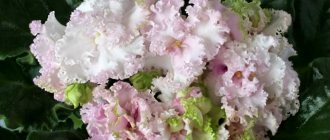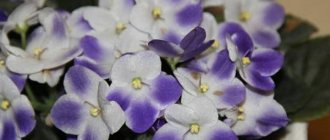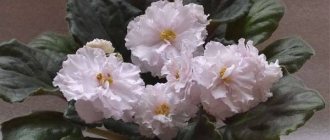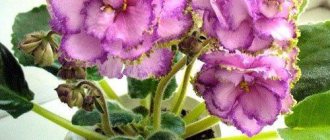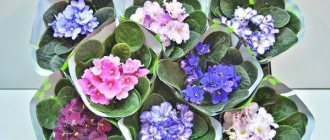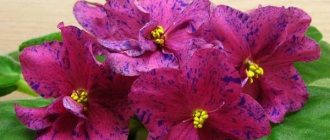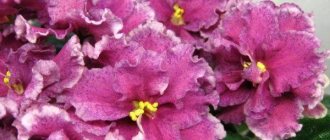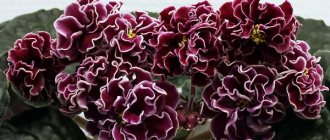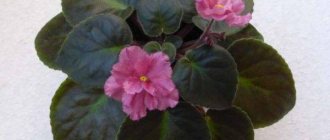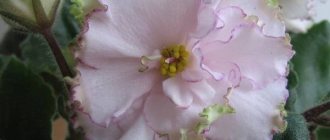Uzambara violets have long become favorites of flower growers ; world-famous breeders, as well as novice specialists in this field, are constantly working on their breeding and obtaining new varieties.
And each of them necessarily has one or more varieties of violets with the adjective “favorite” in the name. Such names are given to especially successful hybrids or specimens that are somehow extremely dear to their creator, in other words, the favorite varieties of violets.
All these violets differ from each other in decorative qualities, have some peculiarities in their content, and
are united into one group thanks to the tender affection of selection wizards for them.
Violet varieties EK-Gift for a Beloved, RS-Beloved, AV-Favorite Toy, SK-Morning with Beloved, RS-Favorite Blues, WaT-Beloved Wife, Beloved Child, EL-Lubimchik are representatives of the Saintpaulia genus from the Gesneriev family.
From the “Lubimitz” group we can highlight the most impressive varieties from several authors, which are suitable for the collections of flower growers with different experiences with Saintpaulias.
EK-Gift for a loved one
The variegated variety represents the breeding developments of the Togliatti florist Elena Vasilyevna Korshunova . The variety was introduced in 2008.
Species affiliation
The photo and description of the violet EK-Gift for a Beloved make it clear that the variety can be classified according to the standard type , since it forms a neat, medium-sized rosette of leaves.
According to the color of the leaf blades, the plant belongs to the variegated type, according to the color scheme - to the edged type, and according to the number of petals - to the terry type.
Description
In adulthood, the flower has a neat leaf rosette with a symmetrical outline. Leathery, rounded-angular leaves are painted in a very dark tone of green with a frame of thick dotted pinkish tint.
Even a non-flowering Saintpaulia will certainly attract attention with the beauty of the bush.
Belongs to the group of varieties with cap flowering . Large corollas on strong peduncles consist of several layers of petals, due to which a double flower is formed.
Greater volume is given by the fine and frequent fringe of the tips of each petal.
The color scheme is in lilac-blue shades of varying color intensities; a purple ribbon with purple reflections is running across the entire width of the fringe.
Features of growth and flowering
The variety is distinguished by strong characteristics of any stage of the life cycle:
- characterized by rapid growth;
- from the first flowering it gives a magnificent volume of the cap;
- elastic peduncles allow heavy corollas to stay straight;
- Saintpaulia blooms for quite a long time;
- does not impose special requirements on lighting conditions;
- forms a strong root system.
IMPORTANT! The variety is ideal for collectors who constantly participate in various exhibitions, as it likes to independently form a rosette of leaves - and it turns out to be perfectly even.
The nuances of keeping indoor culture
Even beginners in the field of growing violets can cope with this variety. He is not capricious at all, although he belongs to the variegated varieties. The main thing for a florist is to carefully follow standard care regimens.
You can pay attention to the amount of nitrogen when feeding, since overfeeding can lead to the disappearance of leaf variegation.
Reviews
Ekaterina Semyonovna. “Gift for a Beloved” is one of Elena Vasilievna’s most successful varieties. The violet is not picky, grows quickly, blooms vigorously and early. I’ve had it in my collection for a very long time, I couldn’t be happier with it.”
Konstantin. “It’s strange that not enough attention is paid to Saintpaulia “Gift for a Loved One.” Not only does the variety itself form a rosette and does not require special conditions, it also looks royal at any time, with or without flowers! Thanks to E. Korshunova for this violet.”
Reproduction
Violet Yesenia: photo of the variety
Violet Yesenia propagates by seeds, leaves or parts of leaves. The most popular type of propagation is using leaves. This method is the easiest, and at the same time you will retain all the features of this variety. Reproduction technology using a leaf:
- First you need to choose a healthy, large leaf. Important! Old leaves are not suitable for propagation.
- To speed up germination, you can cut off the top of the leaf so that 75% of the plate remains.
- We choose the same soil mixture as in the case of flower transplantation
- Moisten the soil with water
- Place the petiole in the ground, not reaching the leaf.
- Cover the leaf with a plastic container or film, creating a greenhouse effect
- After some time, a new plant should appear next to this leaf.
In six months it will already be a full-fledged plant with its own root system, ready to bloom. You can move the pot to a permanent place and apply all the rules for caring for an adult plant.
RS-Favorite
The delicate variegated variety was obtained by breeder Svetlana Nikolaevna Repkina from Lugansk. Flower growers became acquainted with violets in 2015.
Species affiliation
A photo of the violet RS-Lubimaya gives a complete picture of its appearance. The plant belongs to the standard type , as it forms a not very large rosette. Due to the color of the leaves, the variety belongs to the variegated group, and according to the color of the corollas, it belongs to the border type.
Description
Saintpaulia is distinguished by its smooth, filled rosette . The leaf blades have a rich shade of green with a slight frame of white specks and spots. The petioles are strong and slightly elongated.
Refers to varieties with a bouquet type of flowering. Very large buds are densely collected in the center of the leaf rosette.
Due to the small number of petals, the corollas belong to the semi-double variety, but the wavy tips of the petals give the flowers additional volume.
The color of the violet is close to a fantasy version : the center of the flower is occupied by a white star, the petals are painted in shades of pink, their tips are shaded by an edging of lilac-cherry dots, and bluish splashes are visible over the entire surface of the flower.
Features of growth and flowering
The “Lyubimaya” variety is distinguished by its very early first flowering - newly rooted children are already capable of forming buds. Each flowering is characterized by an abundance of blossoming corollas.
The violet spends a very short period of time resting after flowering and is again ready to form buds even without replanting. Blooms for a long time.
The splendor and size of flowers increases with each new flowering. The variegated color of leaf blades with the age of the plant is also capable of increasing brightness and volume.
The nuances of keeping indoor culture
Violet “Favorite” is a fairly easy variety to care for . The only difficulty can be presented by its variegated leaf feature.
When fertilizing, it is important to control the percentage of nitrogen component in fertilizers . Since nitrogen helps to increase chlorophyll, with a large volume of it, leaf variegation may disappear.
ATTENTION! To maintain the decorative appearance of the rosette, it is better to keep the variety in cool conditions (up to +18 +20°C) - the white edging becomes brighter.
Reviews
Anna Nikolaevna. “I want to share my experience with flower growers who have the “Favorite” variety in their collections. For additional winter lighting, place the lamps at a considerable distance from the violet leaves. For me and my friend, from the bright light, the edge of the leaves almost disappeared and turned into a pink thread. After the lamps were removed, the variegation returned. Be careful!"
Sofia. “I really like the delicate variety “Favorite”. I received a leaf at an exhibition, it took root quickly, formed a small rosette and has already formed buds. I'm looking forward to early flowering."
Features of flowering, growth and reproduction
In order for Iceberg to enjoy flowering for a long time, it is necessary to observe the light regime . 12 hours of light and 6 hours of complete darkness.
In winter, violets require additional lighting.
How long does it take to grow an adult plant?
An adult Iceberg violet plant (LLG/Sorano) will grow under favorable conditions and proper care in 10-11 months.
Reproduction methods and features
- We cut a healthy, beautiful leaf from the second row of the plant;
- We cut the cuttings at an angle;
- Choose a pot with a diameter of up to 6 cm;
- We root the cuttings into the ground;
- Cover with a greenhouse;
- The baby will arrive in a couple of weeks.
Leaf cuttings can be rooted in boiled water and then transplanted into the ground.
Varietal characteristics are transmitted only with leaves without spots and with a light petiole.
Important! The darker the petiole and the more pigment spots on the leaf, the bluer the color of the petals.
What do flower stalks look like?
Peduncles of medium length, light. When the flowers of a variety begin to darken, the peduncles also become darker .
Is it possible to achieve cap flowering?
Iceberg has bouquet flowering , and each time the shape of the bouquet is different.
The variety in question often blooms luxuriantly.
Bud lifespan
From the opening of the bud to the wilting of the flower, 5-6 days pass .
RS-Favorite Blues
Another variety of breeding research by S.N. Repkina , presented to flower growers in 2011 . You can see a photo of the violet RS-Favorite Blues below.
Species affiliation
The violet variety “Favorite Blues” is of the standard type , of the terry type in terms of the number of petals in the bud, and of the finger type in terms of color.
Description
Specimens of the variety are distinguished by a standard-sized rosette, the outline of which is sometimes somewhat ragged. The fullness of the socket is achieved only with age. The leaves have an oval-elongated configuration and are colored in dark shades of green. The reverse side has a reddish tint.
The “Favorite Blues” violet blooms in a bouquet type : large corolla balls are tightly located in the center of the rosette.
Terry is achieved due to the number of petals and the waviness of their tips.
The color of the violet is distinguished by delicate shades - the white petals are filled in a chaotic manner with blurry spots of lilac with transitions of tinting intensity.
Features of growth and flowering
Saintpaulias bloom the first time with the formation of a large number of buds . Further flowering can flow from one to another, the violet does not even take time to rest.
If the care regime is violated, the leaf plates of the violet begin to bend upward, which disrupts the decorative effect of the specimen.
The nuances of keeping indoor culture
An unpretentious variety , it blooms a lot and often under any conditions. The florist only needs to follow all care regimens.
You should not keep fluorescent lamps close to the leaves - from the bright light, the leaf plates bend upward and try to fold in half.
Reviews
Fedor Petrovich. “I advise beginning flower growers to purchase the “Favorite Blues” variety from the collection. Violet does not require care and is always in bloom or in buds. Add cute lilac pom-pom-shaped flowers and you get the idea of Saintpaulia. I won’t be lying if I say that these are now my favorite violets.”
Lyudmila Mikhailovna. “They gave me a small violet. At first I wasn’t impressed by it – just a green bush. But when it bloomed, I fell in love with it. A most delicate, airy bouquet of white and lilac color, very similar to a bride’s bouquet, blossomed in the center.”
Caring for a plant at home
First of all, when growing violets, you need to know how to properly care for them.
Conditions of detention
Proper watering and fertilizing
Watering Saintpaulias should be careful .
Important! When watering, do not allow water to get on the leaves, petioles and growing point.
The ideal option is to water with a small-volume syringe with a long spout. Pour water in a thin stream into the edge of the pot, avoiding washing out the soil.
It is acceptable to water by immersing the pot with the plant in water to a third of its height. Both methods have pros and cons.
When watering from above, there is a risk of not soaking the entire lump of soil and washing out the nutrients. Immersion watering risks alkalizing the substrate, but moisturizes it well. The best option would be to alternate types of watering.
We use tap water for irrigation , standing for 48 hours. The water temperature is 1-2 degrees above room temperature.
The frequency of watering depends on many conditions:
- Soil composition;
- Air humidity;
- Pot volume;
- Plant size and much more.
This variety must be watered on time.
In any case, water only when the surface of the substrate has dried . Watering too frequently will lead to acidification of the soil and rotting of the roots and trunk of the plant.
Lighting and temperature
Violets need:
- Diffuse light in summer (eastern and western window sills);
- And bright light in winter (south windows).
The most favorable temperature is 200C . At this temperature, with a deviation of ±30C, Saintpaulia actively grows and blooms. At temperatures below 130C and above 300C, violets die.
Effect of air humidity
air humidity for violets . This level of humidity in winter can only be maintained artificially.
Pots with violets in winter should be kept as far as possible from radiators and the air should be regularly humidified, preventing water from getting on the plants themselves.
Soil requirements
- Loose, breathable;
- Contains many nutrients;
- pH slightly acidic;
- Should not thicken over time.
Approximate composition of soil for growing Saintpaulia variety Proshka:
- Turf (coniferous, deciduous) land – 30%;
- Vermiculite or Perlite – 30%;
- Sphagnum (coconut fiber) – 30%;
- Nutrient soil – 10%.
You can buy soil for violets or make it yourself.
Pruning and hygiene
When forming a rosette of a violet variety, you need to leave three tiers of leaves , removing the lower ones. Also subject to removal:
- Yellow, damaged leaves;
- Faded flower stalks;
- Excess buds.
Contrary to popular belief, a hygienic shower is good for violets. If the leaves of the plant become dusty, feel free to take them to the bathroom and wash off the dust with a warm shower. The water pressure should not be strong so as not to damage the plant. The violet should dry in the dark.
Dry leaves must be removed from violets.
Important! Wet leaves will get burned in the sun.
Reproduction methods
Like other Saintpaulias, the Proshka variety reproduces :
- Leaf cuttings;
- And children formed on the mother plant.
Transplant rules, rejuvenation
To transplant an adult Saintpaulia, you need to do the following:
- Loosen the earthen lump with a sharp peg;
- Remove the lump from the pot and remove as much of the old substrate as possible;
- If the violet is more than two years old, it would be a good idea to remove the lower third of the root system along with the stem with a sharp knife;
- Place the violet roots in fresh substrate.
Important! The size of the pot should not exceed 9 cm.
Every 2-3 years the plant needs to be rejuvenated . To do this, use a sharp knife to cut under the lower leaves, leaving a stump 0.5 cm long. Dip the stump in water and plant it in fresh soil after roots appear.
AB-Favorite toy
Below you see a photo of the AB-Lubimaya Igrushka violet, a charming variety bred by breeder Alexey Vsevolodovich Tarasov. Violet appeared at exhibitions in 2015.
Species affiliation
There is no clear opinion regarding the species classification of this variety: some gardeners classify it as a small standard , but many prefer to consider it semi-mini.
Description
In accordance with the characteristics of semi-mini varieties, violet forms a very compact and small leaf rosette. The almost round leaves have a wavy serration along the contour and are colored in shades of fresh grass.
The petioles of the leaf blades are thick and somewhat long, but this does not interfere with the perception of the variety.
The variety forms buds in a cap type . The corollas are not very large, terry in appearance. Each petal has a corrugated structure.
In the center of the bud you can see a pink-crimson spot, from which a pink glow spreads across the white petals.
The edges of the petals are framed with a burgundy welt. There are dark pink splashes on the entire surface of the flower.
Features of growth and development
With abundant flowering, the cap of the corollas can almost completely cover the rosette of leaves.
The crimson border of the flowers acquires tonal saturation from flowering to flowering; the same effect is obtained when keeping specimens in cool conditions.
Important! Violet “Favorite Toy” is capable of producing sports with beet-colored corollas.
The nuances of keeping indoor culture
To make it more decorative in the form of a crimson border, the violet should be kept in cool conditions . The rest is care according to the standard scheme.
It should be especially protected from drafts and not placed on cold window sills.
Reviews
Sonechka. “I’ve wanted a small violet for a long time. Finally, they gave me a “Favorite Toy” for my birthday. The best gift! She is so cute and very small! A real toy!”
Alexei. “I gave my wife a new treat for March 8 – a violet “Favorite Toy.” Now I constantly look at the curls of her fringe. And the wife does not leave the flower, she reads literature on care. Thanks to the author of violet - I am now the best husband in the world. But we need new mini violets.”
Conditions for growing at home
Saintpaulias can be placed on the windowsill or on separate shelves, racks and other surfaces.
Did you know? Some gardeners claim that Yesenia's flowers show more white when the air gets cooler, and in warm microclimates they take on a dark blue hue.
For good development and growth they will need:
- lighting - moderate, indirect light;
- watering - it is necessary that the soil is slightly moist;
- air - exclude the presence of drafts and temperature changes.
Location and lighting
The lighting must be bright, but indirect. This will happen if Le Yesenia is placed on a western or eastern window sill. In such conditions, the sun will illuminate the violet well during the first or second half of the day. The correct luminosity for Saintpaulias is about 11,000 lux. The intensity of lighting depends on the time of year. Therefore, violets may need to be moved to another window sill if light conditions change.
Remember to turn the plant ¼ turn after each watering. This will ensure uniform development of the leaf rosette. If you do not do this, it will begin to stretch in the direction of the light source. When using artificial lighting, keep in mind that the distance between the light source and the plant must be at least 0.5 m.
Important! Provide Yesenia with an 8-hour period of darkness per day. This will help activate the flowering hormone.
Air temperature and humidity
In choosing comfortable conditions for development, people and violets coincide.
What is comfortable for you will be comfortable for Saintpaulia:
- air temperature - about +21°C;
- absence of sharp fluctuations in day and night temperatures;
- Optimal humidity is from 70 to 80%.
If the room temperature is below +15°C, the violet may die from hypothermia. A sign of death is “hanging” leaves. If the humidity in the apartment is not higher than 60%, then it can be increased by placing the plant in a tray with pebbles. Water the pebbles, but do not let them sit in the water. The moisture will evaporate when exposed to sunlight, thereby increasing the humidity around the plant.
There should be enough space around the flower for air circulation. This will help protect the flowers from pests and phytopathogens if one of the violets gets sick.
SK-Morning with my beloved
A very popular variety , obtained by breeder Alexey Kuznetsov in 2012.
Species affiliation
Violet SK-Utro with Lyubimaya, in terms of the diameter of the leaf rosette, belongs to the group of mini varieties , and in terms of the shape of the flower, it belongs to the bell-shaped type.
Description
The variety forms a completely miniature, but very full and even rosette. The slightly pointed, heart-shaped leaves have the tonality of young greenery with lightened veins.
Flowering in varietal violets occurs in a bouquet type . The peduncles are tall, thin, but quite strong.
The buds open in the form of bells , consist of one, or less often - two layers of petals, that is, they belong to simple or semi-double forms. The petals are white, with a delicate dusting of pink at the tips.
Features of life cycles
Violet invariably produces an even rosette . All leaf blades tend to bend their sides upward.
It blooms very vigorously and colorfully the first time , preserving the freshness of the flowers for a long time.
A charming feature is the distribution of the pink border only along the edge of the upper petals.
The nuances of keeping indoor culture
The variety is suitable for beginner amateurs:
- characterized by unpretentiousness to the conditions of care;
- does not require special lighting;
- accepts any type of watering.
Saintpaulia grows extremely quickly , so replanting is recommended twice a year.
CAREFULLY! You should not allow elevated temperatures when violet blooms, otherwise its petals will change color and may become completely white.
Reviews
Zinaida Valentinovna. “For the appearance of the violet “Morning with my beloved,” a special “thank you” must be said to the wife of breeder A. Kuznetsov, because she insisted on preserving the seedlings. The name of Saintpaulia was also given by the author’s wife.”
Nyura. “I want to share my joy - my only little one, “Morning with my Beloved,” has bloomed. She has such charming bells of a delicate pink shade that you can’t take your eyes off!”
Violets Carnival: Carnival (F. Tinari) and Granger's Carnival (Eyerdom)
Both varieties belong to the hybrid Saintpaulias of the Gesneriev family.
Pretty Carnival violet (F. Tinari).
Carnival (F. Tinari) - a retro variety, bred in 1967 . Socket:
- Standard;
- Often not formed symmetrically;
- And hugs the pot.
Under favorable conditions it grows into a larger one . Leaves:
- Rounded;
- Slightly pointed towards the ends;
- Light green with long stems.
The flowers are small, but there are many of them on peduncles, the shape resembles Anyutka . The color is fuchsia, with a white border; on the lower petals it is thinner, and on the upper ones it is wide with dark veins.
Mysterious violet Grangers Carnival (Eyerdom).
Grangers Carnival (Eyerdom) is a younger variety than the previous one, and was bred in 1981 . Socket:
- Flat;
- Standard;
- Quite symmetrical, subject to maintenance conditions.
Leaves:
- Medium green;
- Rounded;
- With light corrugation around the edge.
Tends to outgrow the standard size and hugs the potty .
The flowers are medium in size , this is compensated by their quantity, pansy-shaped, with a corrugated edge. The color of the flowers is very interesting:
- The main fuchsia color completely covers the lower petals, with the exception of a thin white border;
- The upper petals are completely white with a clear, venous pattern;
- As they fade, the flowers become lighter.
Important! Sports are rare among these varieties, but if this happens, they are usually mutually sporting. (By multiplying Carnival you get Grangers Carnival and vice versa).
VaT-Beloved Wife
This nice variety belongs to the selection of Tatyana Valkova.
Species affiliation
In terms of rosette size, varietal violet belongs to the standard type , and in terms of the fullness of the flowers, it belongs to the double type.
Description
Violet VaT-Beloved Wife is distinguished by a very symmetrical and dense rosette . The leaf blades have a leathery structure with a glossy surface and are round in shape with a small pointed tip. The color of the leaves is completely unusual - very dark, with a marsh tint.
Violet is distinguished by cap flowering . Large corollas in the form of compact roses are colored with delicate pink tints. The tips of the petals are shaded by a fringe of raspberry color.
Features of growth and flowering
Saintpaulia grows quickly , flowering is not very early, but vigorous and long lasting.
The colorful border on the petals appears with greater brightness with each flowering.
The same effect is obtained when violets bloom in cool conditions, so you should strictly monitor the temperature regime.
Violet leaf blades like to bend their tips downwards, under the rosette.
The nuances of keeping indoor culture
The variety does not have any special care requirements ; standard rules and regimes are suitable for it.
ADVICE! The only caution is not to forget about the violet corset when forming a rosette in order to get a decorative-looking bush.
Reviews
Polina Sergeevna. “Advice to beginning violet lovers - when starting to root the children of the “Beloved Wife” variety, be sure to take care of a corset for violets. Otherwise, it will bend the leaves under the rosette.”
Check mark. “I love my violet “Beloved Wife.” As you might guess, my husband gave it to me. The flower is magnificent: against the background of the marsh color of an even rosette, a beautiful pink and white bouquet.”
Diseases and pests
Most problems associated with diseases arise from improper care. For example, improper watering, or rather overwatering, can affect it; planting a flower too deep in the ground can also cause disease. All violet pests mainly move in the air, so there are practically no methods of protection, but you can minimize their attack. Signs of the presence of pests can be damaged leaves, for example, chewed leaves, or the presence of larvae on the plant. Spraying with insecticides is suitable as a control. To do this, we first protect the plant from others, cover it with a plastic bag, then spray it, this is done with the aim of protecting other plants from pests. In addition to insect pests, violets can suffer from rot. Signs of the disease are considered to be slower growth of the Yesenia violet, fading and falling leaves, and various dark spots on the leaf blade. We carry out treatment as follows:
- First you need to remove the plant along with the roots from the pot.
- We inspect the roots and remove damaged areas
- We also remove damaged areas on the plant itself.
- We completely treat the entire plant with fungicides
- We transplant the violet into a new pot with new soil.
After this, you need to control the watering of the plant and avoid overwatering. Violet Yesenia is a fairly unpretentious plant; with proper care, it will delight you with its flowers and long flowering. If there is sunburn, which appears as light spots on the leaves, the LE Yesenia violet variety must be protected from direct sunlight.
Favorite child
The variety is a representative of a foreign breeding school. Its author is the world famous American breeder Paul Sorano.
Species affiliation
The “Favorite Child” variety, based on the diameter of the leaf rosette is classified as a standard type ; based on the fullness of the flowers, it is classified as a semi-double type.
Description
The violet forms a fairly even rosette of large leaf plates in a shade of lush green. The leaves have a glossy surface with small protruding dots, all edges are wavy jagged and curved.
The corollas consist of a small number of petals, but they look terry due to the thick corrugation at the tips.
The flowers are distinguished by a two-color color : the white main field is surrounded by a delicate lilac edge to the depth of the corrugated cuts.
Features of growth and flowering
The variety is distinguished by the almost simultaneous flowering of all buds , which reduces the period of total flowering. With each new formation of buds, the intensity of the lilac illumination is constantly increasing.
Attention! Saintpaulia very often likes to go into sports.
The nuances of keeping indoor culture
Violet is unpretentious and responds with good flowering to normal care regimens . Suitable for first growing experiences for beginning Saintpaulia lovers.
Reviews
Pyotr Petrovich. “I accidentally saw a photo of the violet Favorite Child (G. Cox/B. Johnson) - the flower seemed small and unprotected. I bought it and cared for it like other violets in the collection. As a result, my baby has grown into a strong bush and has already formed buds. I’m waiting to see what color it will bloom.”
Yadviga Karlovna. “I have the “Favorite Child” variety in my collection. It doesn't bloom for very long, and there aren't many flowers. But I am captivated by the huge wavy leaves with frequent pimples. Violet is one of my favorites.”
EL-Pet
Saintpaulia breeding development by L.A. Eremenko.
Species affiliation
The fantasy variety , in terms of the size of the leaf rosette , belongs to the semi-miniature group, and in terms of the color of the leaves, it belongs to the variegated variety.
Description
The violet forms a dense rosette with an even contour.
The slightly pointed leaf plates have an original color: yellowish-green spots are scattered across the overall dark background, and the leaf veins are tinted with emerald green.
The variety blooms according to the cap type. On very strong peduncles there are corollas of a semi-double configuration.
The color of the flowers is fantastic - pinkish-lilac petals are completely splashed with specks of purple tones.
Features of growth and flowering
Violet EL-Lubimchik forms a rich cap the first time . It blooms for a very long time, sometimes forgetting to leave time to rest.
Violet propagates easily and simply.
The nuances of keeping indoor culture
The variety is perfect for growing your first violets. Completely unpretentious, it allows itself to be replanted in a blooming state without dropping the buds - but such experiments can be carried out only in the most extreme cases.
Reviews
Boris. “The variety “Favorite” completely unexpectedly appeared in my collection (I took away a dying violet from a bakery seller) and really became my favorite. After I managed to get it out, the bush pleases with almost constant flowering. And its flowers are magnificent, pink with blue-violet fantasy.”
Kristina Anatolyevna. “The “Favorite” violet was given to me to start my collection. It has taken root perfectly, blooms very long and beautifully. Now I reproduce it and give it to my friends.”
Botanical description of the plant
Yesenia (Le Esenia) is characterized by large blue-violet-white flowers with the finest ruffle along the edge of the petals. Up to 40 five-petaled flowers rise above a medium-sized rosette. The diameter of the flowers is 3–5 cm. The color of the flowers is not stable and can vary from plant to plant: be lighter or darker. Saintpaulia blooms from September to March. After flowering, each flower forms a small seed capsule.
The plant can reproduce by both seeds and leaves. The leaf rosette is about 40 cm in diameter (standard). The leaves are large, oval, dark green on medium petioles. The stem is the base of the rosette. It may be longer or shorter, depending on the age of the violet. The root system is fibrous, consisting of many identical roots.
